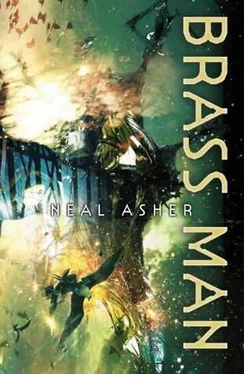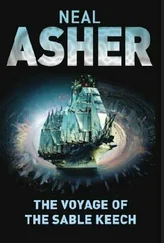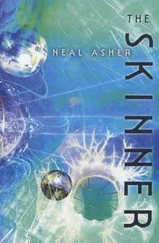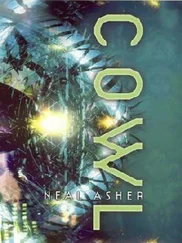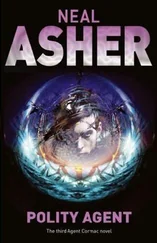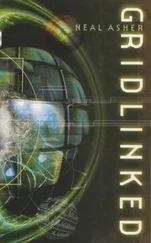‘Do you look directly into U-space?’ he asked Jack.
‘Yes, I do.’ The reply was close at his shoulder, though the hangman automaton still occupied the drawing room behind.
‘And you retain your sanity?’ Cormac shot a glance at the gallows.
‘Yes. AI has never been limited by the four-dimensional view of the universe. It is only by being able to see and comprehend more that we can operate runcibles and ships like this.’
‘But you are physically confined to that universe and subject to its constraints?’
‘For the present.’
Cormac let that one go. No way was he going to get into a metaphysical discussion with an AI—he’d done that before and, rather than gaining enlightenment, ended up with a headache.
After a few minutes, the grey flickered away as the ship surfaced in realspace. The sun was not noticeably smaller, but the asteroid belt was now a wall of rocks beside them. The Jack Ketch eased itself into this wall, tilting and dipping, the drone of its fusion motors changing constantly as it negotiated its way through. Above, below and to the sides, Cormac observed mountain ranges swinging past as fast as fan blades, and saw flares of incandescent gas where proximity lasers hit smaller rocks.
‘This asteroid is actually within the belt then?’ he asked.
‘Its erratic orbit will take it out in fifteen hours, if it is not obliterated meantime. I have it on visual now.’
A square red frame seemingly nickered into existence far ahead of the ship, singling out just one more undistinguished lump of rock.
‘You have to wonder if it is a coincidentally erratic orbit,’ suggested Cormac.
‘Almost certainly not.’
‘Will you be able to moor?’
‘No, the longest mooring time in any location on the surface here is eight minutes before some passing object would hit me. I am now taking out of storage a telefactor unit to send down to investigate.’
‘I want to go with it,’ Cormac said.
‘That is inadvisable. If there is active Jain technology down there, it might kill or sequester you. The telefactor can find out all we need to know, and it’s dispensable.’
‘Everything’s dispensable, and I’m tired of sitting on my hands. Presumably I’ve retained my authority as an ECS agent?’
‘You have, Ian Cormac—I merely advise against you placing yourself in unnecessary danger.’
‘Noted, but I’m still going down.’
‘Very well. You can ride down to the surface with the telefactor. I suggest you go and suit up now.’
The dropshaft shifted while he was in transit, and took Cormac directly to the telefactor launch area. There was no gravity in the wedge-shaped bay and, while he was pulling himself towards the storage area by an airlock designed for humans, he observed the further wall of the bay revolve aside to reveal the unit itself.
Golem androids were often employed by ECS simply because they were more able to utilize equipment originally designed for humans. But even they were now being replaced in some arenas. Cormac had already seen specialized drones, first in Elysium then on Masada. This unit was similar in appearance: a squat cylinder floating vertical to the floor. However, unlike those war drones, this object possessed various arms and probes folded close to its body and a complex array of scanning equipment on its underside. It also possessed no mind of its own, being a telefactor of the Jack Ketch AI.
In storage, Cormac found a standard combat space-suit. It was armoured, possessed greater facility for sealing breaches, and had clinging to its belt an autodoc capable of scuttling to any point on the suit’s exterior, sealing itself to that point, and cutting its way inside to repair the contained body—if it could. Cormac removed that item and left it in the store—the idea of Jain tech subverting such a doc not holding much appeal for him. In the gloves, belt and flat-visor helmet were interfaces for various weapons. Cormac merely attached his thin-gun to the belt, then commenced the always frustrating task of donning a suit in zero gravity.
By the time he was ready, the unit had drifted over by him, bobbing up and down as if impatient to be on its way. A readout in his suit’s visor told him the air was being drained from the bay, then doors, shaped to conform to the edge of the ship, drew back—above and below—onto vacuum.
‘Ready,’ said Cormac.
A ceramal claw snapped out and closed on his belt, and the telefactor unceremoniously dragged him out. Jetting two scalpels of flame, it flung them both towards the revolving stone behemoth. Finally landing, and walking on stick-boots behind the drifting unit, Cormac swore upon coming in sight of the bridge pod of the Occam Razor. His subsequent language when he spotted the explosive bolts embedded in stone—sure sign that a ship had recently landed—even evinced some surprise from Jack.
* * * *
A gust of wind rattled the skeletal branches of the chequer trees and shook free some of their few remaining square leaves, which drifted down like stripped-off skin in the bloody moonlight. The not-rabbits fled into the undergrowth as a still and oppressive heaviness weighed the air. Seemingly from nowhere, the revenant stepped into view: the walking desiccated corpse of a man who had been burnt to death. Walking woodenly out from between the chequered trunks and down the rock-scattered slope to the red mirror of the lake, this zombie creaked and crunched with each step, dry or charred skin and the remains of clothing flaking away from him. In his legs, dry fibrous muscle was visible, fraying and splintering as it was worked by other fibrous tendrils wound through it. Reaching the gritty shore, this creature knelt and dipped its hands into the peaty water, and from those hands fibrous tendrils sprouted and grew, expanding as they absorbed water, diving finally into the fertile mud of the lake bottom. Then the revenant began to change.
In gradual stages, he transformed from a desiccated corpse into something newer, fresher. Skin, burnt black, became grey and slimy, and slewed away from red surfaces glistening with plasma and dotted with blood. Around deeper burns, lumps of seared fat and muscle dropped away to expose similar surfaces. Exposed bone stretched and writhed, flaking away ash to expose gleaming white, which was then marred—and given a metallic hue—by a creeping grid, before being covered by a writhe of veins across its surface.
The revenant tilted his head one way, and the woody structure supporting one side of it turned soft and wet, and began to sink into exposed raw flesh. He then tilted his head the other way, and the crystal of his AI aug, still glittering with green light, was flooded with hair-like tendrils, and deformed itself against his head. Sucking back into itself the rods that connected down into his chest, the aug sank away into his skull, to become skinned over with bone and a sudden growth of veins, then muscles opening like summer flowers. The only sign that remained of it was a glint of green deep in the empty eye socket, but even this blinked out as, starting as a shiny black bead extruded into position, an eyeball expanded to fill the cavity.
Skin formed first as a layer of clear slime, which grew opaque, began to knit, thickened and toughened, and conformed itself to the growing structures underneath. Briefly, it covered completely the new-grown eyeball, then split into lids that sprouted lashes. Brown hair then issued from the bare scalp, while the skull underneath still shifted and deformed, as if the head itself were having difficulties returning to its customary shape with all the extras it now contained. But eventually this settled down too. Now the man removed his hands from the water—no sign of those tendrils he had earlier extruded—and watched his fingernails grow. Eventually he stood, naked in the red moonlight, and looked around. On the horizon, he located the yellow-orange glow of city light—and began to walk towards it.
Читать дальше
